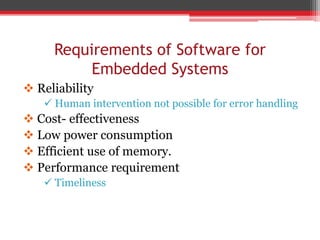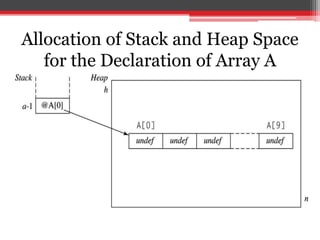Software for embedded systems complete
- 1. Software for Embedded Systems Designed & Presented by, Anand K
- 2. Embedded Software Software interacting with the physical world o it takes time. o it consumes power o it does not terminate. Embedded software o hidden in watches, mobile phones, iPods o guided missiles, controls satellites o used in automotive instruments. Varying requirements and hardware platform.
- 3. Requirements of Software for Embedded Systems Reliability Human intervention not possible for error handling Cost- effectiveness Low power consumption Efficient use of memory. Performance requirement Timeliness
- 4. Features of Embedded Software Timeliness Computation takes time Even Infinitely fast computer embedded software needs to deal with time because the physical processes with which it interacts evolves over time. Concurrency Engage with the physical world where multiple things happen at once. Liveliness Program must not terminate or block waiting for events that will never occur. Heterogeneity Different computational styles and implementation technologies Interact with events occurring Reactivity React continuously to the environment at the speed of the environment.
- 5. Real Time The time between presentation of a set of inputs to a system and the realization of the required behavior including availability of the associated outputs, is called the response time of the system. A real-time system is a system that must satisfy explicit bounded response time constraints or risk severe consequences including failure Soft Real-time systems Hard real-time systems
- 6. Software Quality Measurement Dynamic efficiency Number of CPU cycles required. Static efficiency RAM size Global variables and stack. ROM size Fixed constants and program code. Power consumption. Correctness. Easy to understand Easy to change Flexibility and maintainability
- 7. Developing Software Determine requirements Product functionality Design the System Architecture Select the Operating System(if any) Choose the development platform Code the application Optimize the code according to the requirement. Verify the software on the host system Execution within a simulator environment. Execution within an emulator environment. Verify the software on the target system.
- 8. Make Process Compiling o Parsing, Semantic Analysis and Object Code Generation o Processor specific characteristics to be exploited for efficient code generation o Cross-compiler or cross-assembler Run on host to produce code for target. Linking o Merge sections from multiple object files o Unresolved reference to symbols replaced by reference to actual variables or function calls o A special object file that contains compiled start-up code also included o Start-up code: Small block assembly language code that prepares the way for the execution of the code
- 9. Startup code o Start-up code usually consists of following actions in sequence. Disable all interrupts. Copy any predefined data from ROM to RAM. Zero the uninitialized data area. Allocate space and initialize the stack. Initialize processor’s stack pointer Create and initialize the heap Enable Interrupts. Call main o Programmer may need to write his own start-up code and link(if necessary) Img.jpg
- 10. Memory Allocation o RAM Memory Global variables. Heap Stack • Local variables • Return addresses • Temporary data. o Content changes at run-time
- 11. Memory Allocation o ROM memory Machine Codes Fixed constants o If both ROM and EPROM partitioning depending upon the requirements of the design. Configuration data Flash Data store(RAM buffer) o Slower compared to RAM
- 13. Desirable HLL features o Versatile parameter passing Call by value Copied into stack at considerable execution time Large data structures never passed by value. Call by reference Indirect instructions used; time for execution of procedure more.
- 14. Desirable features Global variables Vs parameter lists References to global variables faster- direct addressing Parameters make interfaces clearly defined Parameters can increase interrupt latency. • interrupts disabled during parameter passing
- 15. C for Embedded Systems o The practices that characterize Embedded C development: ▫ In-line Assembly language ▫ Device knowledge ▫ #pragma directive ▫ Endianness ▫ Mechanical knowledge ▫ knowledge of specific device/peripheral operation o Processor dependent objects like characters, bytes, bits and addresses can be handled directly to be manipulated to control interrupt controllers, CPU registers etc. o The @ operator associates port register with identifier in #pragma port statements o C provides special variable types like register, volatile, static, and constant
- 16. C for Embedded Systems o Storage modifiers register – variables to be frequently used, compiler places in a register. static – private communication in modules. Static variables initialized only once, visible within a single compilation unit. extern – extern variables are meant to be allocated memory only once across several modules. auto – by default all local variables are declared as ‘auto’ o Data type Identifiers const • Allocated in ROM or any other NV memory volatile – variables whose values may change outside of the executing software.
- 17. Memory management in C o Static Allocation Global variables, variables with static qualifier Memory allocated during compile or link time Advantage of modularising the data within a program design. o Automatic Allocation At run time in stack for variables defined in every function Compiler provides support for allocation and access to these variables
- 18. Dynamic Allocation Dynamic allocation Allocation of memory at run-time on demand Allocation and de-allocation under program control. Allocated from a large pool of unused memory area called Heap Memory accessed indirectly, via pointer reference
- 19. Dynamic Allocation Memory space in the heap is not always allocated and deallocated from one end (like the stack). If a block of sufficient size is found then it is allocated and the pointer returned. If no block is found to satisfy the request then a heap overflow error is returned. Allocation in heap area Memory in heap as chunk of unit sizes 16,32, etc. Memory is actually acquired or released in the units in which the memory is divided. o wastage of memory o Internal fragmentation
- 20. Allocation of Stack and Heap Space for the Declaration of Array A
- 21. Heap Management A map of space allocated is kept so that, when a block is deleted, the correct amount of space is returned to the free list. Smaller unit size minimizes wastage but increases memory requirement for maintaining data about the allocated blocks free() returns unit to heap o using free() more than once on the same pointer can result in inconsistency
- 22. Difficulties Memory leak memory allocated, not freed not available subsequently “Run forever” can result in system failure due to cumulative effect of small memory leak Dangling pointers
- 23. Thank U























